With only 26.8 inches between the SuperLow’s saddle and the tarmac, a safe guess might say that, of the 30-plus motorcycles in Harley’s expansive lineup, the SuperLow has the lowest seat height. Guess again.
While the SL has a notably low span from seat to ground, it isn’t the lowest seat height from Harley. That distinction belongs to the Softail Deluxe and its 25.9-inch seat height. Truth is, several other models boast seat heights lower than the SuperLow, even if only by a couple tenths of an inch.
So what gives with the name? As recently as model year 2010 the 883L, another entry-level Harley with a low seat height and equally low MSRP, bore Low as part of its moniker. The SuperLow surfaced in 2011 and is the latest, freshest version of the 883L. The newly updated model name hints at the friendly seat height and price – key attributes that riders looking at the SuperLow might find appealing.
With the new name came a number of changes that Harley says were at the behest of dealers and consumers alike. The 883L’s, or rather the SuperLow’s, fuel tank capacity was increased, and rider ergo improvements included thicker seat foam. New wheel and tire sizes altered the bike’s stance, appearance and, according to Harley, improved handling.
The SuperLow, powered by the venerable 883cc air-cooled Harley V-Twin, holds the honor of possessing the lightest claimed dry weight in Harley’s stable in 2012. At 536 pounds dry, the SL is nine pounds lighter than the next two lightest bikes, the Nightster and Forty-Eight, and 12 pounds lighter than the Iron 883.
With all fluids and a full tank, the SuperLow scales in with 563 pounds, one pound more than the Nightster, and two pounds less than the Iron 883. This bodes well for the Nightster when we consider it’s powered by a larger, 1200cc Twin. Nevertheless, the SuperLow has a good excuse for the extra pounds it piles on.
With 4.5 gallons of fuel capacity the SL carries 1.2 gallons more petrol than the Iron 883 and Nightster; and the peanut-tanked Forty-Eight has less than half the fuel capacity of the SuperLow. Suddenly the SuperLow’s near parity in wet weight with its larger-engined brothers isn’t such a big deal, especially if the SuperLow can keep cruising while the others need to pit in for fuel.
What is for sure low about this Sporty is its MSRP.
In the standard black paint scheme (Vivid Black) the SuperLow offers entry to the world of Harley-Davidson in 2011 – ‘12 for $7999, as does the identically priced Iron 883. While the SuperLow’s price shouts, “Bargain basement Harley,” its styling and overall performance say, “Heritage of a big Harley without the big price tag.”
Plopping my 5 foot 8 inch frame in the Super’s sculpted saddle revealed the bike’s rider triangle is, as expected, a snug fit. But the pullback handlebar didn’t require that I reach very far to comfortably clasp onto the grips. A handlebar with less pullback would’ve demanded more reach, subsequently creating the sensation of a too-cramped ride, as I would’ve been closer to the tank.
My torso was mostly centered over the seat, which meant I was upright without feeling awkwardly positioned despite the bike’s diminutive dimensions.
Footpeg placement is mid-mount style, and while my knees were in a comfortable 90-degree bend, even my short-ish 30-inch inseam wished for pegs a little further forward. Additionally, the pegs are set rather far from the center of the bike – not a big deal, but their orientation created a minor inconvenience for shifting, as I had to deliberately toe-in to upshift. When I became conscious of this necessary motion it made me think that if I owned a SuperLow one of the first things I’d do is scout the aftermarket for a shift lever with a longer peg.
The SuperLow’s layout never struck me as uncomfortable, but my guess is that riders hovering around 6-feet-plus who also desire a low seat will want to look elsewhere in Harley’s line for a low-saddle model that provides roomier ergos.
The smallest displaced air-cooled 45-degree Vee from Harley pops to life quickly. The EFI instantly and reliably regulates idle speeds. The dual staggered shotgun exhaust emits the familiar Harley rumble, which, for whatever reason this time, struck me as burly sounding as the 96 and 103-inch engine Harleys.
Clutch pull effort is easy enough, but newer riders may need additional time to acclimate to the burst of torque right off idle. This quick jolt of torque from a dead stop results largely from the clutch engaging near the end of the clutch lever’s release point. But as noted, given some time in the saddle, this peccadillo will fade from the rider’s consciousness. The 883 makes most of its peak torque in the 2000 rpm range, which is another reason this little Harley feels so strong right out of the gate.
As the SuperLow purposefully glides forward you won’t notice fueling and throttle response, because each of these functions is wonderfully smooth and transparent. Power delivery from the classic Milwaukee mill is linear, and more importantly for riders interested in this model, power delivery is predictable.
While you needn’t concern yourself with break-neck speeds, the 883cc Twin is nevertheless peppy. The SL achieves freeway cruising pace in short order and without much effort, with room to spare for overtaking slower vehicles.
But observant riders will note the engine starts feeling busy as early as 60 mph, even while in top gear. The engine feels like it has ample power in reserve to pull a larger (i.e. taller) top gear in its five-speed transmission; a taller top gear might make the engine feel a little less active. I made a similar comment on the gearing in our single-bike review of the 2010 883 Low.
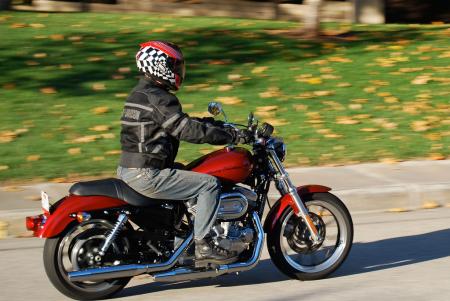 |
Other minor but noteworthy shortcomings became more apparent while bombing down the interstate, an environment that sometimes gives a rider time to take notice of things great and small.
One such nit pick was how my elbows obscured the rearward view from the mirrors – an issue usually plaguing the just-there-to-appease-DOT-regulation mirrors often found on sportbikes. Longer mirror stalks for the SuperLow seem like the simple fix here. Not as readily apparent as the mirrors’ stingy view is the sometimes-unforgiving ride quality.
A little more than two inches of rear suspension travel doesn’t leave much room for the dual coil-over shocks to soak up big, jarring freeway expansion joints. The 39mm Showa fork’s 4-plus inches of suspension travel is fairly standard for a cruiser, and so it does a better job of eating crummy pavement. Credit for helping smooth out the ride goes to the Michelin Scorcher II tires. The plump 120/70 x 18 front bun does a good job of mitigating road imperfections before they reach the rider, more so than the narrower 100/90 x 19 front tires found on the Iron 883 and Nightster, and formerly on the 883L.
Despite the fatter front tire and steering geometry more relaxed than the Iron or Nightster, the SuperLow nevertheless is a breeze to maneuver.
Whether at parking-lot pace or darting along winding roads, initiating a turn doesn’t require any noticeable effort, and transitioning left to right, side to side, is also a low-energy affair. What will require some mental energy is reminding yourself the footpegs will augur into the pavement in no time flat while completing even the most mundane cornering action – low seat heights courtesy of limited suspension travel have a cost.
However, like most things that demand near-constant attention early on, the scraping and grinding of the pegs will happen less often as you become more comfortable with the sensation and learn the bike’s lean-angle limits.
From prior experience with the dual-piston single front caliper found on many Harley cruisers I didn’t anticipate anything beyond adequate stopping power from the SuperLow’s front brake. This particular brake, however, supplied better than average feel and plenty of stopping force. A solid two-finger squeeze on the brake lever was all I ever really needed to reel in the SL.
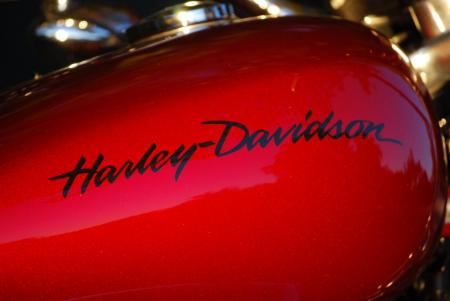 |
The SuperLow: The Gateway to Harley-Davidson
The Sportster SuperLow lacks the fat torque numbers produced by the larger 96 and 103-inch Harley engines; it doesn’t provide storage like Harley’s renowned tourers and bagger models, and it offers none of the ostentatious flash of the upscale CVO line.
Despite the SuperLow’s humble station in Harleyland it hits all the right Harley themes: unarguably iconic styling, relaxed riding position, the soft sound of rolling thunder, unintimidating but useful power and an engine recognizable the world over, placed jewel-like in the center of it all. And a bountiful aftermarket ready to meet your customization desires.
The SuperLow embodies the core of a Harley-Davidson motorcycle, and at the same time grants easy access to the Harley mystique.
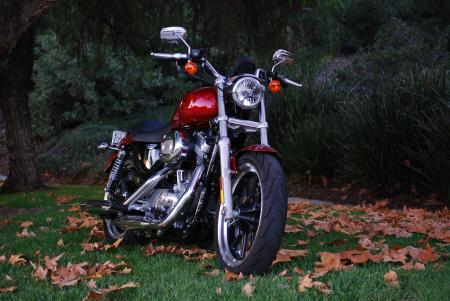 |
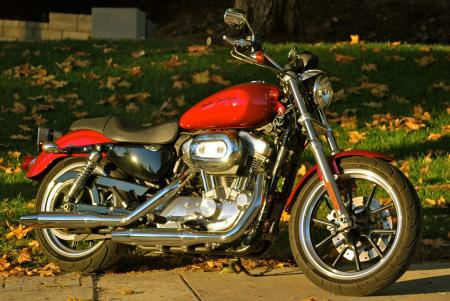
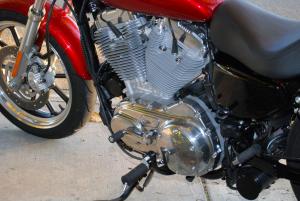
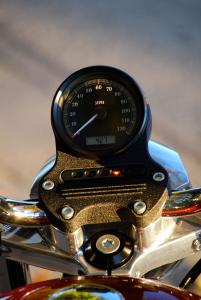
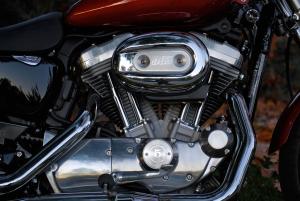
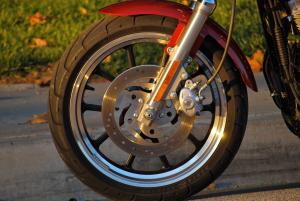
No comments:
Post a Comment